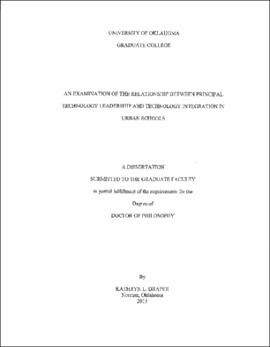| dc.contributor.advisor | Maiden, Jeffery | |
| dc.creator | Draper, Kathryn | |
| dc.date.accessioned | 2019-04-27T21:27:11Z | |
| dc.date.available | 2019-04-27T21:27:11Z | |
| dc.date.issued | 2013 | |
| dc.identifier | 99201051002042 | |
| dc.identifier.uri | https://hdl.handle.net/11244/318720 | |
| dc.description.abstract | The purpose of this exploratory/quantitative descriptive and correlational study was to examine the relationship between principal technology leadership and technology integration in urban schools. The technology activities of principals along with Organizational Health Instrument (OHI) survey outcomes perceived by their faculty were described and analyzed to discover if there was a relationship between and among them. The targeted sample was school administrators in two urban school districts in Oklahoma and Texas. Oklahoma participants came from 11 elementary schools, one middle school, one high school, and one middle/high school. Texas participants came from one Montessori school, 10 elementary schools, one middle school, one high school, and one alternative middle school. The Survey of Technology Competency and Proficiency to the National Educational Technology Standards of Administrators (STCP-NETS-A) was used for technology-related data gathering. Participants responded using a 5-point Likert scale. Survey data were combined from daily and weekly to form at least weekly versus monthly or less with respondents answering at least weekly in their responses and combined agree and strongly agree as well as disagree and strongly disagree to form agree versus disagree. For the review of data from surveys, descriptive analysis was used, such as percentages, means, standard deviations, and item analysis. Data from the OHI surveys from each participating urban school were used to examine the relationship to culture and student achievement. The data were displayed across each of the 10 dimensions using descriptive analysis, including percentages, means, and standard deviations. In addition to descriptive analysis, survey data were analyzed using inferential statistics. An analysis of variance was used to determine if there were significant differences in school health among school principals' perceptions of their leadership competencies in four OHI dimensions. Analysis of data involved an overview of the 29 urban school principals with information analyzed from each survey. Findings indicated a high level of frequency in technology productivity use for administrators. Findings further indicated a high level of frequency in technology perception and beliefs about the positive impact of technology in the school setting. These findings indicate that principals' perceptions of technology's influence plays a key role in the integration occurring at schools. Survey results revealed strong technology leadership behaviors and use of a variety of technology in schools. Findings further indicated nonsignificant differences in technology integration and school organizational health indicators relative to student achievement. Analysis of survey results supported a null hypothesis that there was no relationship between the technology behavior of urban school principals and the four organizational health dimensions that correlate to high student achievement in schools. | |
| dc.format.extent | 175 pages | |
| dc.format.medium | application.pdf | |
| dc.language | en_US | |
| dc.relation.requires | Adobe Acrobat Reader | |
| dc.subject | Educational technology--Oklahoma | |
| dc.subject | Educational technology--Texas | |
| dc.subject | Urban schools--Oklahoma--Administration | |
| dc.subject | Urban schools--Texas--Administration | |
| dc.subject | Educational leadership--Oklahoma | |
| dc.subject | Educational leadership--Texas | |
| dc.title | AN EXAMINATION OF THE RELATIONSHIP BETWEEN PRINCIPAL TECHNOLOGY LEADERSHIP AND TECHNOLOGY INTEGRATION IN URBAN SCHOOLS | |
| dc.type | text | |
| dc.type | document | |
| dc.thesis.degree | Ph.D. | |
| ou.group | Jeannine Rainbolt College of Education::Department of Educational Leadership and Policy Studies | |
